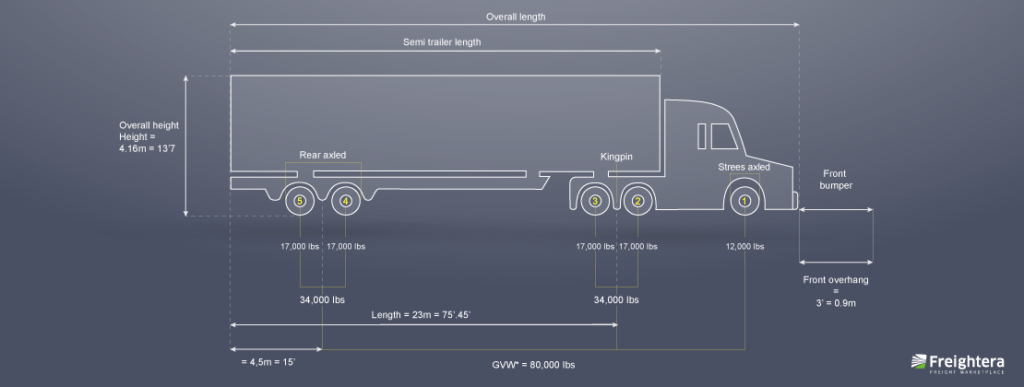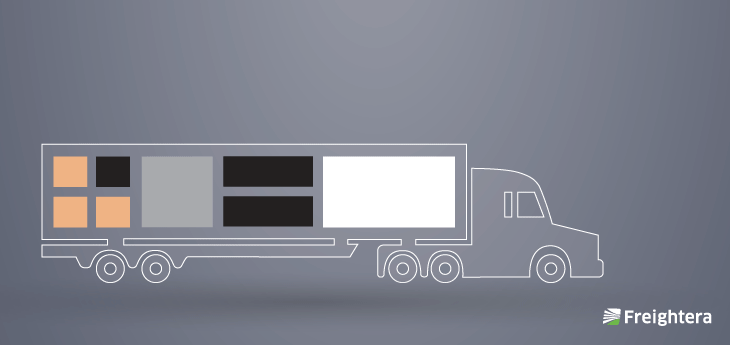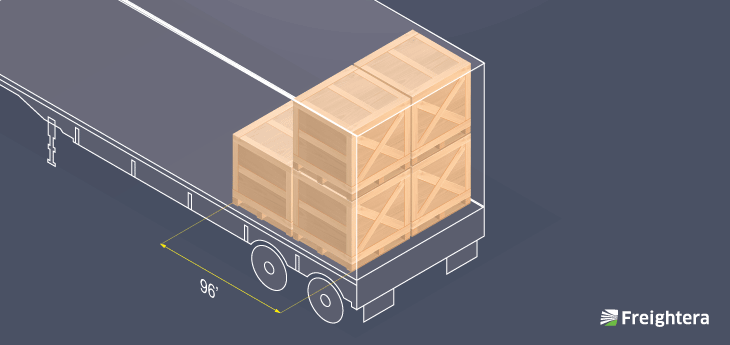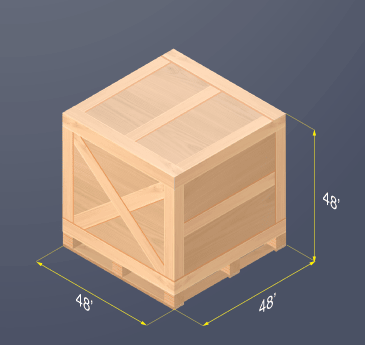Linear Feet, Dimensional Weight and Axle Weight

[Updated June 2023]
Linear Feet, Dimensional Weight and Axle Weight: Freight Shipping Terms That Could Save You Money
Linear Feet
When it comes to LTL shipping, getting acquainted with linear feet can help save you some money.
The linear feet of your cargo represent the length that your shipment takes up in the truck. The standard length of a freight truck trailer is 53 feet.
The standard width of a trailer is 96 inches. This means that two standard skids of 48 x 48 x 48 inches can be placed one next to the other in a truck, taking up only 48 inches of linear feet.
However, if you’re shipping two slightly larger skids, for instance, 53 x 53 x 78 inches, then those two skids will not fit in the truck one next to each other. That means that your shipment would take up 106 inches of linear space.
The standard height of a trailer is 96 inches. This is important because it gives you some wiggle room if your shipment is stackable (meaning that it can be placed on top or under other cargo).
For example, if you are shipping five standard pallets of 48 x 48 x 48 inches, they will take up 96 inches of linear space.
Four pieces can be stacked one on top of the other, taking up 48 inches of linear space. The last skid being the odd one out will have to be placed “behind” the others. If the 5th skid is stackable, this will still allow you to get better pricing as another shipper’s order can still be placed on top of yours. However, your shipment will still take up 96 inches of linear space.
Dimensional Weight
Dimensional weight (also known as dim weight) is a billing method used by some carriers. What it means is that they might use dimensional weight in determining the price of the shipment, rather than the actual weight of the cargo.
Dimensional weight is calculated by multiplying the length, width and height of your shipments.
If you are shipping a skid of 48 x 48 x 48 inches you may get some incredibly high numbers by simply multiplying the numbers (over 110,000). This will not be your chargeable weight.
Some carriers simply disregard the dimensional weight if it’s over 1100 while others divide the number by 139. For a standard shipment with the dimensions of 48 x 48 x 48 inches, this would bring your dim weight to around 796.
The carrier will charge for whichever weight is greater, be it the actual weight or the dim weight.
Carriers don’t charge more simply because they can. There are good reasons for these pricing methods. Read on and find out why.
When shippers ship larger cargo there tends to be a lot of padding and cushioning in order to avoid damage. This takes up unnecessary space in the carriers’ trucks that could otherwise be occupied by other cargo. The carriers’ way of dealing with this is dim weight.
In order to promote more economical packaging and less cargo “bloat”, shippers that do not overly pad their cargo will have lower shipping costs with carriers that use dim weight.
Axle (Axial) Weight
Axle weight represents the amount of weight a single truck axle can support. That means that your shipment can be considered as taking up more space than it actually does if it is overly heavy.
For instance, if you are shipping one pallet that is very dense, weighing 5000 or 6000 lbs, your shipment will severely limit the amount of additional cargo that the carrier can put in that part of the truck.
This does not mean that you should separate every shipment into 5 skids. As noted above, some carriers will respond to this by charging based on dim weight.
However, if your shipment is overly heavy, you do want to try and spread out the weight as much as possible or separate it into a few lighter skids.
If you are unsure what might be the best solution for you, please always feel free to reach out to your super-friendly Freightera Client Care specialist for assistance.
How to adjust
As with everything in shipping, there is no universal answer. Most issues vary from case tp case.
In general, you want to make sure that each individual pallet you’re looking to ship is reasonably heavy and (if at all possible) up to 48 inches in length and width. Of course, if you’re shipping construction materials or heavy machines you may not have a choice, but at Freightera we’re always looking for the best carrier option for you.
Our system is smart enough to find the cheapest option for you on its own. For the rare occasion that it isn’t, it will direct you to our super-responsive shipping experts for the human touch that might be needed.
Give it a try at Freightera and see our excellent freight quotes for yourself, completely free and available in 15 seconds!


